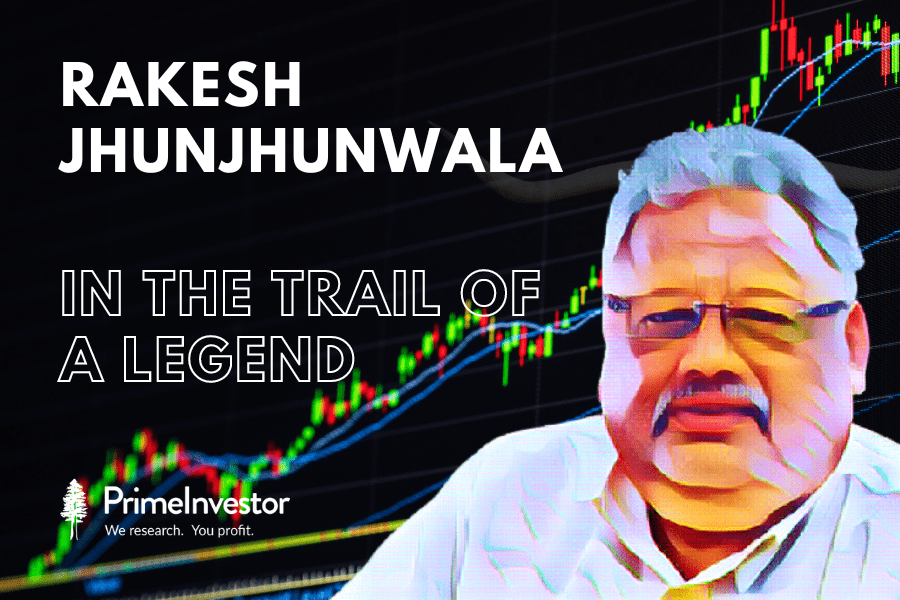We have periodically written about and updated you on Rakesh Jhunjhunwala’s portfolio. This blog series will sadly have to end with RJ’s demise. RJ’s candle may have burnt out but his legend will live on – both his legacy and the hope he carried in equities.
With an investment portfolio of $5 billion, Rakesh Jhunjhunwala (RKJ) has left a rich legacy behind him. While he started the journey with a modest capital that compounded over 3 decades, it is a record that may find it hard to be broken. In the words of his close aide Ramesh Damani, a proponent of compounding, it is over 50% CAGR in 35 years.
If we have to recollect a record that is extremely hard to be broken, it would be the 99.94 test cricket average of cricketing legend Don Bradman 😊

As tributes started pouring in and a lot was being written, an interview from a market veteran caught my attention. Ramesh Damani, a long-time friend and veteran investor, portrayed his journey and reason for his success wonderfully. Being a veteran investor himself, Damani brought out the key traits that led to the stupendous success of Rakesh Jhunjhunwala over his close circle of friends, including the likes of Ramesh Damani, Radhakishan Damani and Nemish Shah.
“We all picked great stocks, we all had multi-baggers, we all compounded our wealth. But there is “something” that he did totally different from all of us that made him far ahead of us” said Damani.
And the “something” he did differently in his early days included borrowing, taking leveraged positions and a trading book to generate capital – something that didn’t find favour with the others.
Yes, he started his career with an appetite for high risk but he didn’t end so. As he wound up his life account, the bulk of his wealth was represented by some of the highest quality companies that are leaders in their respective space and were held for a significant length of time. That makes his journey very special and leaves an opportunity for us to browse through his investment life.
Had he listed RKJ Holdings, it would have been among top 200 companies (after 50% discount to holding value) by market capitalisation and a sought-after stock by investors like the cult Berkshire Hathaway created among the Indian elite investors and fund managers.
Before discussing further, let me put a caveat. His journey is an inspiration and may not be a path that a majority of the retail or part-time investors can take.
But for passionate investors who have made up their minds for a full-time investing journey and put hard efforts, there are some valuable lessons from his journey.
In this discussion let us take our eyes off the size of his corpus and focus on the lessons.
1. Investing is a long-term compounding journey
In the investing world, compounding is considered to be the eighth wonder. To put it simply, using the rule of 72, a 24% CAGR will double money every 3 years.
Here, the return in the 8th year is more than the invested capital itself and it is when compounding truly kicks in.
This is what happened for investors who bought shares of well-known companies at early stages and held on for a decade or more.
For Rakesh Jhunjhunwala, Titan is his largest holding worth Rs.10,000 crore. The same was worth Rs.5,000 core 2 years ago while it was worth Rs.1,000 crore a decade ago, compounding at 24%. Earnings of Titan compounded at 16% in the last decade. But in markets, return is a sum of earnings compounding and PE re-rating and that makes the stock price compound at a higher rate.
While Titan is a blue-chip today with a market cap of over Rs2 lakh crore with annual profit of over Rs.3,000 crore, RJ started investing when the stock’s market cap was Rs.300 crore.
Early investors in blue-chip stock like Infosys, TCS or HDFC Bank, Bajaj Auto, Asian Paints, Marico or even a Page Industries or V Guard would have enjoyed this kind of a journey where the profits today are far higher than corpus invested and the market cap is manifold times higher than when they were bought. This is when compounding attains its true worth and it happens over a decade or more of holding the stocks.
So, staying invested for long and compounding are the two key elements for wealth creation and even a few winners can make a real difference to your portfolio returns.
2. Riding the winners, cutting the losers
Even as we spoke about compounding, it is riding the winners that allows your portfolio to compound at an above average return. Quite often, we see this “riding the winners” strategy playing out better in individual investors’ portfolios than in fund portfolios. This is either due to a concentrated approach or because individual investors allow the stocks to gain concentration with time, without trimming them. On the other hand, fund portfolios generally start with very low allocation or keep trimming their allocation in a stock beyond a certain point either due to regulatory constraints or as part of their risk management process.
In Rakesh Jhunjhunwala’s portfolio, post the stellar listing of Star Health and Metro Brands, these two stocks along with Titan accounted for 66% of his portfolio. In the case of renowned investor Warren Buffett – Apple formed 47% of his portfolio after quadrupling in 4 years. But did they start with such high allocation to those stocks? NO.
It is the approach of “riding the winners” that allowed such stocks to form a disproportionate share of their portfolios. But it is an extremely difficult “art” to practice. This is because a few shake-up events (economic/corporate/market) can throw investors out of a stock and put an end to a journey. And it is always hard for us humans to give up the gains we made!
Though this may be against the conventional wisdom of position sizing or allocation, there isn’t a second-best option for an individual stock investor as only a few of their investments will turn out to be such big winners. The strike rate for a multi-bagger would be 1 in 10 or 5 in 50, not more, even at this best. One can’t look for perfect diversification (and risk) and aspire for market beating returns. It is an ‘either or’ game not an ‘and’ game.
Rakesh Jhunjhunwala had his own long list of losers such as A2Z, DB Corp, Autoline, Bilcare, Prakash Industries that perished. And there is a list of laggards such as NCC, Rallis, Geojit, Agrotech foods, Karur Vysya that didn’t do anything for a decade. He plunged into DHFL and Indiabulls Real Estate when the prices crashed to realise later that those were blunders.
But riding the winners allowed him to take care of the rest of the failures. He did cut down a few losers like DHFL and Indiabulls quickly after realising the mistakes, but not all of them.
Starting with a few diversified picks to allow winners to ride and cutting down losers on time is the only path to take the journey to fruition. Read our more detailed article on how to implement the strategy of riding winners and cutting the losers.
3. In investing, temperament is more important than intellect
During his interviews, Rakesh Jhunjhunwala has always mentioned George Soros as the international investor he liked and who famously said “It is not whether you are right or wrong that’s important, but how much money you make when you are right and how much you lose when you are wrong”
This doesn’t mean “put all your eggs in one basket” and bet on something or bear the $1 billion trade of Soros in your head always. It is clearly about finding out a few good opportunities and placing bets based on risk-reward.
It was not the money alone that was compounding, but the knowledge and experience as well.
Over a period of time, Rakesh Jhunjhunwala turned his attention to investments in the unlisted space where he bought an 18% stake in Star Health and an even larger stake in Cadila’s animal health business along with a consortium of PE players. His huge success with Titan gave him the bandwidth to look for larger deals outside of the market and he didn’t shy away. Though he had amassed huge wealth in Titan, he was ready to jump out of that comfort zone to make bigger investment decisions like that of Star Health and Zydus Animal Health, ending up as a Promoter of those companies.
This happens when an investing journey attains maturity. But it may be decades away for anyone starting with a modest and realistic corpus today. A focused and committed investment journey will add significant value over a period of time that makes one better off in one’s judgement and decision making. But, those with the right temperament may be able to switch gears and make bigger decisions than continuing it the way they started.
It is the temperament that matters and not the corpus at that stage as one would have attained meaningful corpus, knowledge and experience in a few decades. It was not the money alone that was compounding, but the knowledge and experience as well.
4. Understanding the risk-reward right
Rakesh Jhunjhunwala’s recent bet to promote an Airline called Akasa Air is a great case of his understanding of risk-reward. He was doing this at a time when his health was deteriorating and he still moved on to launch the airline while tweets started pouring in that “the best way to become a millionaire is to start an airline as a billionaire”.
But, by making a fixed commitment of Rs. 250 -300 crore that is <1% of his net-worth, he was taking a bet – where he would lose just 1% of his corpus if he went wrong but would gain in multiples if he got it right, with his 40%+ ownership of the business. Afterall, it was not a case of airline space having only losing stories. There have been success stories such as Southwest airlines and Ryan air. And the opportunity in India itself is changing, not just from the size of opportunity, but on infrastructure and the cost of owning and operating an airline as well.
Metro brands is another case in point where he placed a small bet that turned out to be a 100 bagger at today’s price and occupied the third slot in his portfolio. Though the market has well accepted the IPO and the business prospects, it was a company with few outlets when he invested and footwear retailing as a story was yet to take off. As the management shared during the pre-IPO call, RJ’s cost was Rs.8/- per share.
These examples leave a wonderful message on risk-reward. Don’t shy away from placing an initial bet (as a % of corpus) if the opportunity size is huge for a business. If the business economics prove to be right and it is available at the right valuation (normally doesn’t happen so), add more or just ride it.
So, the underlying thought process is containing the downside while leaving the upside open – heads I win, tails I won’t lose. As Howard Marks wonderfully put in his May 2022 lecture on RISK at Wharton, risk is the ultimate test of investing skill. Real achievement is in making returns with less proportionate risk.
Of course, Rakesh Jhunjhunwala was taking much higher risks compared to his close circle of friends in the early days when he had little capital to invest – by borrowing, taking leverage and trading. But he took it early when he could afford to fail. As he amassed huge wealth, he reversed it and ended up owning few high-quality companies and also becoming promoter of few large companies such as Star health and Zydus animal health apart from his other investments. If we call his beginning as a “trader” the end is that of a “business man” and one among the top 100 businessmen in the country.
Final thought: Keep the eye on Compounding, not Corpus
The story of Rakesh Jhunjhunwala is very inspiring for any investor as he leaves a great legacy. Being vocal about his investments and opinions, he influenced millions of retail investors to believe in equities and invest. Like the Economist put it “he was a bull of a man” indeed!
But do remember for most of us, what he achieved may be a record that may not be broken. But the lessons can help travel the road less travelled.
- Take risks early and fail early
- Prepare for a long-term compounding journey
- Learn to ride winners and cut the losers
- Play with the right temperament when it is time to switch gears
It is a journey that requires plenty of commitment and effort to get each and every aspect right. And the target should not be just the corpus; rather it should only be “compounding” at above average rate. Only then is the game worth playing, like the way Rakesh Jhunjhunwala did.







1 thought on “Rakesh Jhunjhunwala – in the trail of a legend”
Great article which sums up the principles of investing for the long term. The first two points are wonderfully elaborated in the book Coffee Can investing.
Comments are closed.